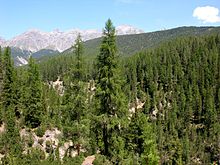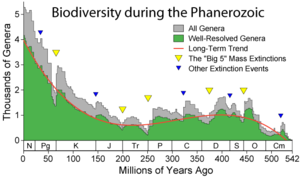Distribution
Biodiversity is not evenly distributed, rather it varies greatly across the globe as well as within regions. Among other factors, the diversity of all living things (biota) depends on temperature, precipitation, altitude, soils, geography and the presence of other species. The study of the spatial distribution of organisms, species and ecosystems, is the science of biogeography.
Diversity consistently measures higher in the tropics and in other localized regions such as the Cape Floristic Region and lower in polar regions generally. Rain forests that have had wet climates for a long time, such as Yasuní National Park in Ecuador, have particularly high biodiversity.
Terrestrial biodiversity is thought to be up to 25 times greater than ocean biodiversity. A recently discovered method put the total number of species on Earth at 8.7 million, of which 2.1 million were estimated to live in the ocean. However, this estimate seems to under-represent the diversity of microorganisms.
Latitudinal gradients
Generally, there is an increase in biodiversity from the poles to the tropics. Thus localities at lower latitudes have more species than localities at higher latitudes. This is often referred to as the latitudinal gradient in species diversity. Several ecological mechanisms may contribute to the gradient, but the ultimate factor behind many of them is the greater mean temperature at the equator compared to that of the poles.
Even though terrestrial biodiversity declines from the equator to the poles, some studies claim that this characteristic is unverified in aquatic ecosystems, especially in marine ecosystems. The latitudinal distribution of parasites does not appear to follow this rule.
Hotspots
A biodiversity hotspot is a region with a high level of endemic species that has experienced great habitat loss. The term hotspot was introduced in 1988 by Norman Myers. While hotspots are spread all over the world, the majority are forest areas and most are located in the tropics.
Brazil's Atlantic Forest is considered one such hotspot, containing roughly 20,000 plant species, 1,350 vertebrates and millions of insects, about half of which occur nowhere else. The island of Madagascar and India are also particularly notable. Colombia is characterized by high biodiversity, with the highest rate of species by area unit worldwide and it has the largest number of endemics (species that are not found naturally anywhere else) of any country. About 10% of the species of the Earth can be found in Colombia, including over 1,900 species of bird, more than in Europe and North America combined, Colombia has 10% of the world's mammals species, 14% of the amphibian species and 18% of the bird species of the world. Madagascar dry deciduous forests and lowland rainforests possess a high ratio of endemism. Since the island separated from mainland Africa 66 million years ago, many species and ecosystems have evolved independently. Indonesia's 17,000 islands cover 735,355 square miles (1,904,560 km2) and contain 10% of the world's flowering plants, 12% of mammals and 17% of reptiles, amphibians and birds—along with nearly 240 million people. Many regions of high biodiversity and/or endemism arise from specialized habitats which require unusual adaptations, for example, alpine environments in high mountains, or Northern European peat bogs.
Accurately measuring differences in biodiversity can be difficult. Selection bias amongst researchers may contribute to biased empirical research for modern estimates of biodiversity. In 1768, Rev. Gilbert White succinctly observed of his Selborne, Hampshire "all nature is so full, that that district produces the most variety which is the most examined."
Evolution and history
Biodiversity is the result of 3.5 billion years of evolution. The origin of life has not been definitely established by science, however some evidence suggests that life may already have been well-established only a few hundred million years after the formation of the Earth. Until approximately 600 million years ago, all life consisted of archaea, bacteria, protozoans and similar single-celled organisms.
The history of biodiversity during the Phanerozoic (the last 540 million years), starts with rapid growth during the Cambrian explosion—a period during which nearly every phylum of multicellular organisms first appeared. Over the next 400 million years or so, invertebrate diversity showed little overall trend and vertebrate diversity shows an overall exponential trend.This dramatic rise in diversity was marked by periodic, massive losses of diversity classified as mass extinction events. A significant loss occurred when rainforests collapsed in the carboniferous. The worst was the Permian-Triassic extinction event, 251 million years ago. Vertebrates took 30 million years to recover from this event.
The fossil record suggests that the last few million years featured the greatest biodiversity in history. However, not all scientists support this view, since there is uncertainty as to how strongly the fossil record is biased by the greater availability and preservation of recent geologic sections. Some scientists believe that corrected for sampling artifacts, modern biodiversity may not be much different from biodiversity 300 million years ago., whereas others consider the fossil record reasonably reflective of the diversification of life. Estimates of the present global macroscopic species diversity vary from 2 million to 100 million, with a best estimate of somewhere near 9 million, the vast majority arthropods. Diversity appears to increase continually in the absence of natural selection.
Evolutionary diversification
The existence of a "global carrying capacity", limiting the amount of life that can live at once, is debated, as is the question of whether such a limit would also cap the number of species. While records of life in the sea shows a logistic pattern of growth, life on land (insects, plants and tetrapods)shows an exponential rise in diversity. As one author states, "Tetrapods have not yet invaded 64 per cent of potentially habitable modes and it could be that without human influence the ecological and taxonomic diversity of tetrapods would continue to increase in an exponential fashion until most or all of the available ecospace is filled."
It also appears that the diversity continue to increase over time, especially after mass extinctions.
On the other hand, changes through the Phanerozoic correlate much better with the hyperbolic model (widely used in population biology, demography and macrosociology, as well as fossil biodiversity) than with exponential and logistic models. The latter models imply that changes in diversity are guided by a first-order positive feedback (more ancestors, more descendants) and/or a negative feedback arising from resource limitation. Hyperbolic model implies a second-order positive feedback. The hyperbolic pattern of the world population growth arises from a second-order positive feedback between the population size and the rate of technological growth. The hyperbolic character of biodiversity growth can be similarly accounted for by a feedback between diversity and community structure complexity. The similarity between the curves of biodiversity and human population probably comes from the fact that both are derived from the interference of the hyperbolic trend with cyclical and stochastic dynamics.
Most biologists agree however that the period since human emergence is part of a new mass extinction, named the Holocene extinction event, caused primarily by the impact humans are having on the environment. It has been argued that the present rate of extinction is sufficient to eliminate most species on the planet Earth within 100 years.
New species are regularly discovered (on average between 5–10,000 new species each year, most of them insects) and many, though discovered, are not yet classified (estimates are that nearly 90% of all arthropods are not yet classified). Most of the terrestrial diversity is found in tropical forests and in general, land has more species than the ocean; some 8.7 million species may exists on Earth, of which some 2.1 million live in the ocean.


No comments:
Post a Comment